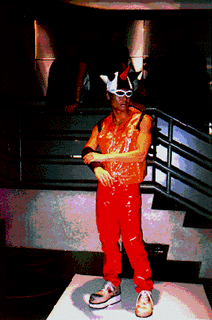
beauty and the bits

 Designers Ricardo Prado, Maria Ella Carrera, and Josefina Batres Technology Collaborator Joshua Weaver, Nuria Oliver, and Barbara Rosario |
Van and WearASL An outfit designed for the blind and deaf. The year 2017 "Dominico" wears a hat that helps translate American Sign Language (ASL) into speech. There's a camera eye embedded in the front lirapipe of Dominico's hat. The camera tracks the movement of his hands as he signs and relays the images back to the computer. The backpack straps house speakers. A snap button on his vest is secretly a microphone and the front design detail is really a Braille display. Dominico is set up for two-way communication. His hat, backpack, and vest coordinate to translate ASL into speech and speech into Braille. |
| Accessor-eyes The Year 2017 "Ariana" is a student and avid pop music fan who happens to be blind. Ariana's earrings contain microphones and speakers. She can use them as a cellular phone to access long-range verbal directions and addresses (her arm piece is equipped with GPS), or she can use them as a short term direction-finder. The speaers emit a tone or click that sounds as if it is coming from the direction she needs to go in. All she needs to do is "follow the sound-crumbs" to get where she is going. Her ring has optical character recognition that scans for characters and translates them into Braille that can be read with a finger or a thumb. Ariana can read the newspaper on the bus, check the pricetag of a new sweater, and find that great album she's been hearing for weeks on the radio. Her shoes reduce stress on her feet with shock absorbency technology that makes constant dynamic adjustments for various terrains and speeds. All three of these accessories are linked to and controlled by the molded CPU on Ariana's arm. Here she can input information and queries and choose output preferences (verbal, Braille, or vibration). |

Designers Nanae Hashimoto, Ai Mizuno, and Seonhya Na Technology Collaborator Brad Rhodes |

Designers Misa Harrada, Ryo Hihara, Nao Muramatus, Kwiko Minomo, and Junko Ito Technology Collaborator Thad Starner |
Geo-Chameleon The year 2008 Geologist "Lance Smith" has two days of light left to explore the Fjord for deposits and precious minerals. His chameleeon coat, mole gloves, sensor sneakers and VR glasses help him beat his deadline. The coat is made of a chameleon material that uses microencapsulated electrophoretic ink to change color and blend with the background, helping Lance escape detection by rival mineral collectors. The coat so provides temperature regulation. Lance's glasses are equipped with a laser range finder, a compass, and differential GPS, all of which allow him to generate made-to-order satellite images of the site. Coupled with digital photographic images, the satellite images construct a "virtual reality" of a particularly inaccessible ledge. Since much of what Lance is searching for is under the earth, his boots have sensors that identify the presence of a particular mineral by glowing in different colors. Once he knows where to dig, his mole-gloves. equipped with search-light and retractable shovel-fingers, help him get to the mineral. A built-in spectrometer displays the identifying information on a wrist-screen. The outfit is powered by a battery cell fed by piezo-electric polymers in his pants. Lance keeps in touch with his wife through their reciprocating wedding rings. The rings transmit biosignals via satellite to any location on the globe. |
|
Ring-Keyboard NTT, Japan The year 1997 A non-MIT outfit worn by Mr. Fukumotu (NTT): the shock-sensor rings allow to type on any surface and translate the different finger combinations into syllables. Data are transmitted to the main computer through the watch. |

|